In Situ Imaging of Domain Structure Evolution in LaBGeO5 Single Crystals
Abstract
:1. Introduction
2. Materials and Methods
3. Results
3.1. Nucleation, Growth, and Merging of Isolated Domains
3.2. Formation and Growth of Stripe Domains
3.3. Domain Shrinkage
4. Discussion
5. Conclusions
Supplementary Materials
Author Contributions
Funding
Acknowledgments
Conflicts of Interest
Appendix A. SHG Cherenkov Domain Structure Imaging
- Color inversion for increasing the image clarity (Figure A1b).
- Contrast enhancement.
- Cropping to exclude the poorly focused outer regions of an image.
- Rotation of the image to align the Y axis of the sample horizontally.
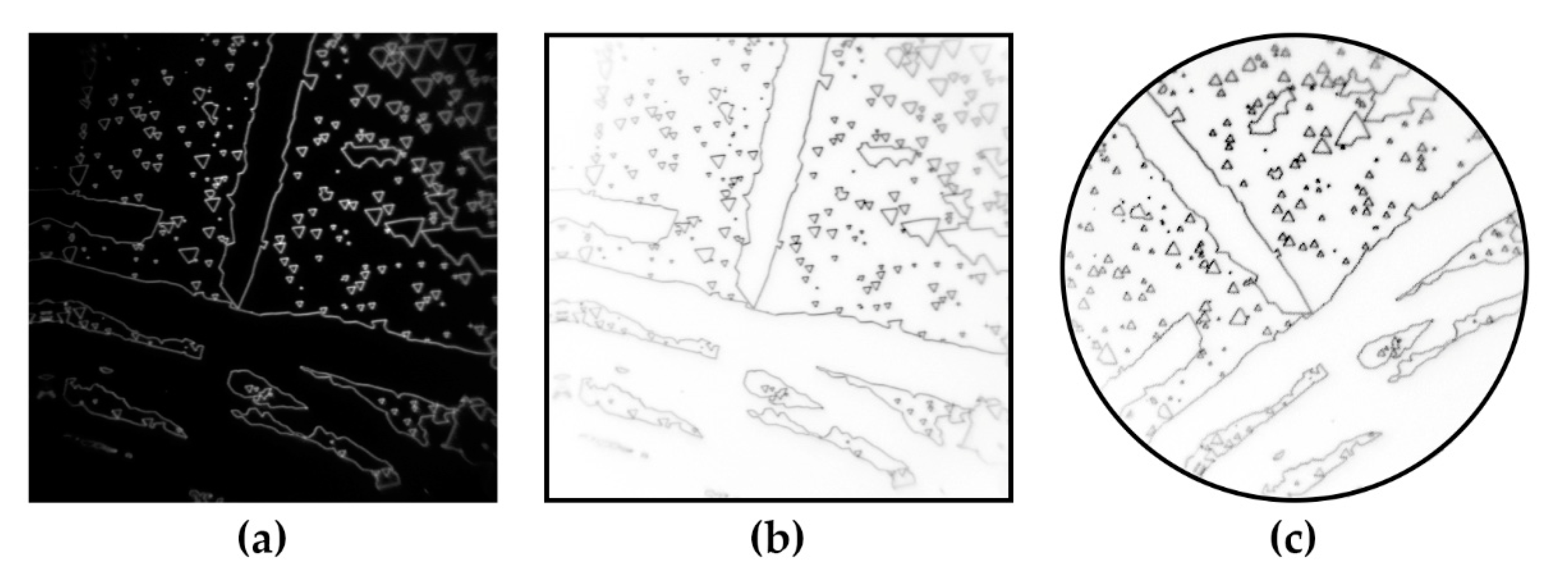
Appendix B. Calculation of the Barrel Distortion
- The obtained plot was fitted by the sum of triangle and circle representations in polar coordinates (Figure A2d):where Rt is a circumradius of a triangle, Rc is a radius of a circle, φ0 is a triangle rotation angle, and is a remainder of an integer division of by .
- The barrel distortion (γ) is calculated as:
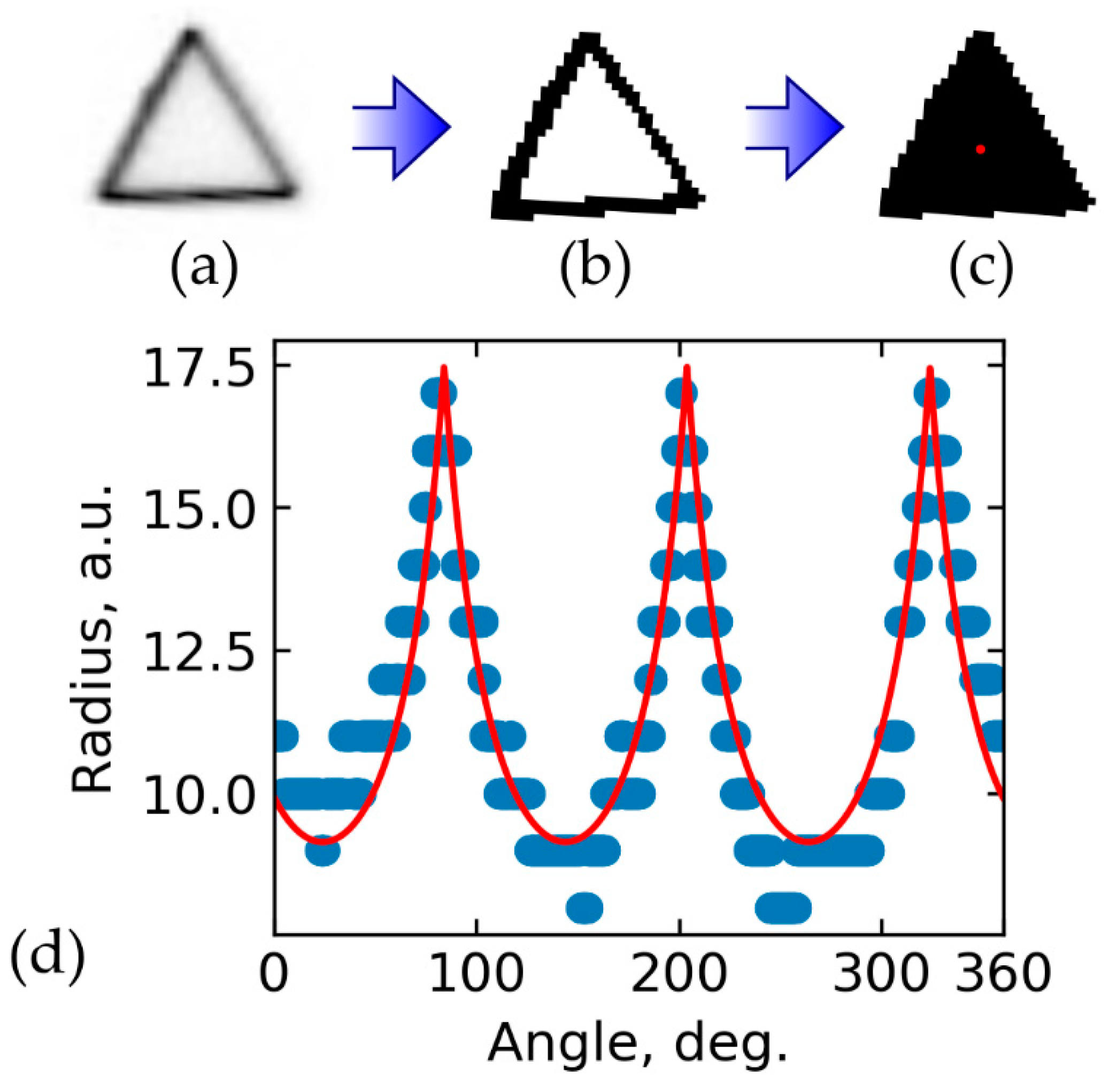
References
- Kaminskiĭ, A.A.; Mill’, B.V.; Butashin, A.V. New low-threshold noncentrosymmetric LaBGeO5:Nd3+ laser crystal. Sov. J. Quantum Electron. 1990, 20, 875–876. [Google Scholar] [CrossRef]
- Kaminskii, A.A.; Butashin, A.V.; Maslyanizin, I.A.; Mill, B.V.; Mironov, V.S.; Rozov, S.P.; Sarkisov, S.E.; Shigorin, V.D. Pure and Nd3+-, Pr3+-ion doped trigonal acentric LaBGeO5 single crystals nonlinear optical properties, Raman scattering, spectroscopy, crystal-field analysis, and simulated emission of their activators. Phys. Status Solidi A 1991, 125, 671–696. [Google Scholar] [CrossRef]
- Horiuchi, N.; Osakabe, E.; Uesu, Y.; Strukov, B.A. Nonlinear optical properties of new ferroelectric LaBGeO5. Ferroelectrics 1995, 169, 273–280. [Google Scholar] [CrossRef]
- Shur, V.Y. Nano- and micro-domain engineering in normal and relaxor ferroelectrics. In Handbook of Advanced Dielectric, Piezoelectric and Ferroelectric Materials; Ye, Z.-G., Ed.; Woodhead Publishing: Cambridge, UK, 2008; pp. 622–669. ISBN 978-1-84569-186-8. [Google Scholar]
- Shur, V.Y.; Akhmatkhanov, A.R.; Baturin, I.S. Micro- and nano-domain engineering in lithium niobate. Appl. Phys. Rev. 2015, 2, 040604. [Google Scholar] [CrossRef]
- Byer, R.L. Quasi-phasematched nonlinear interactions and devices. J. Nonlinear Opt. Phys. Mater. 1997, 6, 549–592. [Google Scholar] [CrossRef]
- Hirohashi, J.; Hatori, M.; Sakairi, M.; Miyazawa, S.; Takekawa, S.; Taniuchi, T.; Furukawa, Y. Second harmonic UV generation by novel periodically poled ferroelectrics. In Proceedings of the Advanced Solid-State Lasers Congress, Paris, France, 27 October–1 November 2013; OSA: Washington, DC, USA, 2013; p. AM3A.2. [Google Scholar]
- Hirohashi, J.; Taniuchi, T.; Imai, K.; Furukawa, Y. PP-LBGO device with 2nd-order QPM structure for 266 nm generation. In Proceedings of the CLEO: Science and Innovations conference, San Jose, CA, USA, 10–15 May 2015; OSA: Washington, DC, USA, 2015; p. STh3H.5. [Google Scholar]
- Hirohashi, J.; Imai, K.; Watanabe, S.; Sakairi, M.; Tomihari, Y. Fabrication of PP-LBGO device for 266 nm generation with the 1st order QPM structure (Conference Presentation). In Proceedings of the Nonlinear Frequency Generation and Conversion: Materials and Devices XVIII, San Francisco, CA, USA, 5–7 February 2019; p. 1090206. [Google Scholar]
- Onodera, A.; Strukov, B.A.; Belov, A.A.; Taraskin, S.A.; Haga, H.; Yamashita, H.; Uesu, Y. Thermal and dielectric properties of a new ferroelectric LaBGeO5. J. Phys. Soc. Jpn. 1993, 62, 4311–4315. [Google Scholar] [CrossRef]
- Uesu, Y.; Horiuchi, N.; Osakabe, E.; Omori, S.; Strukov, B.A. On the phase transition of new ferroelectric LaBGeO5. J. Phys. Soc. Jpn. 1993, 62, 2522–2523. [Google Scholar] [CrossRef]
- Umemura, N.; Hirohashi, J.; Nakahara, Y.; Oda, H.; Furukawa, Y. Temperature-dependent quasi phase-matching properties of periodically poled LaBGeO5. Opt. Mater. Express, OME 2019, 9, 2159–2164. [Google Scholar] [CrossRef]
- Belokoneva, E.L.; David, W.I.F.; Forsyth, J.B.; Knight, K.S. Structural aspects of the phase transition in LaBGeO5. J. Phys. Condens. Matter 1997, 9, 3503–3519. [Google Scholar]
- Strukov, B.A.; Uesu, Y.; Onodera, A.; Gorshkov, S.N.; Shnaidshtein, I.V. Effect of Nd3+ doping upon ferroelectric properties of LaBGeO5 crystals. Ferroelectrics 1998, 218, 249–255. [Google Scholar] [CrossRef]
- Milov, E.V.; Strukov, B.A. Pyroelectric effect and spontaneous polarization in high-temperature ferroelectric LaBGeO5 (LBGO). Phys. Solid State 2001, 43, 513–516. [Google Scholar] [CrossRef]
- Milov, E.V.; Strukov, B.A.; Milov, V.N. Spontaneous polarization and domain reversal in new ferroelectric LaBGeO5. Ferroelectrics 2002, 269, 15–20. [Google Scholar] [CrossRef]
- Strukov, B.A.; Milov, E.V.; Milov, V.N.; Korobtsov, A.P.; Tomida, T.; Sato, K.; Fukunaga, M.; Uesu, Y. Switching processes and formation of the stable artificial domain structure in ferroelectric LaBGeO5. Ferroelectrics 2005, 314, 105–113. [Google Scholar] [CrossRef]
- Akhmatkhanov, A.R.; Plashinnov, K.S.; Milov, E.V.; Shneidshtein, I.V.; Turygin, A.P.; Shur, V.Y. Switching current shape analysis in LBGO single crystals. IOP Conf. Ser. Mater. Sci. Eng. 2018, 443, 012001. [Google Scholar] [CrossRef]
- Milov, E.; Milov, V.; Strukov, B.; Ymazaki, K.; Uesu, Y. Polarization switching and domain structure in LaBGeO5 crystals. Ferroelectrics 2006, 341, 39–48. [Google Scholar] [CrossRef]
- Hirohashi, J.; Taniuchi, T.; Imai, K.; Furukawa, Y. Non-walk-off second harmonic 532 nm generation by PP-LBGO at room temperature operation. In Proceedings of the Advanced Solid State Lasers, Berlin Germany, 4–9 October 2015; OSA: Washington, DC, USA, 2015; p. AM2A.6. [Google Scholar]
- Sheng, Y.; Best, A.; Butt, H.-J.; Krolikowski, W.; Arie, A.; Koynov, K. Three-dimensional ferroelectric domain visualization by Čerenkov-type second harmonic generation. Opt. Express OE 2010, 18, 16539–16545. [Google Scholar] [CrossRef]
- Esin, A.A.; Akhmatkhanov, A.R.; Shur, V.Y. Tilt control of the charged domain walls in lithium niobate. Appl. Phys. Lett. 2019, 114, 092901. [Google Scholar] [CrossRef] [Green Version]
- Kirbus, B.; Godau, C.; Wehmeier, L.; Beccard, H.; Beyreuther, E.; Haußmann, A.; Eng, L.M. Real-time 3D imaging of nanoscale ferroelectric domain wall dynamics in lithium niobate single crystals under electric stimuli: Implications for domain-wall-based nanoelectronic devices. ACS Appl. Nano Mater. 2019, 2, 5787–5794. [Google Scholar] [CrossRef]
- Kämpfe, T.; Reichenbach, P.; Schröder, M.; Haußmann, A.; Eng, L.M.; Woike, T.; Soergel, E. Optical three-dimensional profiling of charged domain walls in ferroelectrics by Cherenkov second-harmonic generation. Phys. Rev. B 2014, 89, 035314. [Google Scholar] [CrossRef]
- Kämpfe, T.; Reichenbach, P.; Haußmann, A.; Woike, T.; Soergel, E.; Eng, L.M. Real-time three-dimensional profiling of ferroelectric domain walls. Appl. Phys. Lett. 2015, 107, 152905. [Google Scholar] [CrossRef]
- Wehmeier, L.; Kämpfe, T.; Haußmann, A.; Eng, L.M. In situ 3D observation of the domain wall dynamics in a triglycine sulfate single crystal upon ferroelectric phase transition. Phys. Status Solidi Rapid Res. Lett. 2017, 11, 1700267. [Google Scholar] [CrossRef]
- Shur, V.Y.; Esin, A.A.; Alam, M.A.; Akhmatkhanov, A.R. Superfast domain walls in KTP single crystals. Appl. Phys. Lett. 2017, 111, 152907. [Google Scholar] [CrossRef]
- Shur, V.Y.; Gruverman, A.L.; Letuchev, V.V.; Rumyantsev, E.L.; Subbotin, A.L. Domain structure of lead germanate. Ferroelectrics 1989, 98, 29–49. [Google Scholar] [CrossRef]
- Shur, V.Y.; Akhmatkhanov, A.R.; Chezganov, D.S.; Lobov, A.I.; Baturin, I.S.; Smirnov, M.M. Shape of isolated domains in lithium tantalate single crystals at elevated temperatures. Appl. Phys. Lett. 2013, 103, 242903. [Google Scholar] [CrossRef] [Green Version]
- Lobov, A.I.; Shur, V.Y.; Baturin, I.S.; Shishkin, E.I.; Kuznetsov, D.K.; Shur, A.G.; Dolbilov, M.A.; Gallo, K. Field induced evolution of regular and random 2D domain structures and shape of isolated domains in LiNbO3 and LiTaO3. Ferroelectrics 2006, 341, 109–116. [Google Scholar] [CrossRef] [Green Version]
- Esin, A.A.; Akhmatkhanov, A.R.; Shur, V.Y. Superfast domain wall motion in lithium niobate single crystals. Analogy with crystal growth. Appl. Phys. Lett. 2019, 114, 192902. [Google Scholar] [CrossRef]
- Gopalan, V.; Jia, Q.X.; Mitchell, T.E. In situ video observation of 180° domain kinetics in congruent LiNbO3 crystals. Appl. Phys. Lett. 1999, 75, 2482–2484. [Google Scholar] [CrossRef]
- Gopalan, V.; Mitchell, T.E. In situ video observation of 180° domain switching in LiTaO3 by electro-optic imaging microscopy. J. Appl. Phys. 1999, 85, 2304–2311. [Google Scholar] [CrossRef]
- Gopalan, V.; Mitchell, T.E. Wall velocities, switching times, and the stabilization mechanism of 180° domains in congruent LiTaO3 crystals. J. Appl. Phys. 1998, 83, 941–954. [Google Scholar] [CrossRef] [Green Version]
- Shur, V.Y.; Nikolaeva, E.V.; Shishkin, E.I.; Chernykh, A.P.; Terabe, K.; Kitamura, K.; Ito, H.; Nakamura, K. Domain shape in congruent and stoichiometric lithium tantalate. Ferroelectrics 2002, 269, 195–200. [Google Scholar] [CrossRef]
- Ishibashi, Y.; Takagi, Y. Note on ferroelectric domain switching. J. Phys. Soc. Jpn. 1971, 31, 506–510. [Google Scholar] [CrossRef]
- Cahn, J. Theory of crystal growth and interface motion in crystalline materials. Acta Metall. 1960, 8, 554–562. [Google Scholar] [CrossRef]
- Shur, V.Y.; Rumyantsev, E.L. Crystal growth and domain structure evolution. Ferroelectrics 1993, 142, 1–7. [Google Scholar] [CrossRef]
- Shur, V.Y. Kinetics of ferroelectric domains: Application of general approach to LiNbO3 and LiTaO3. J. Mater. Sci. 2006, 41, 199–210. [Google Scholar] [CrossRef]
- Tagantsev, A.K.; Cross, L.E.; Fousek, J. Domains in Ferroic Crystals and Thin Films; Springer: New York, NY, USA, 2010; ISBN 978-1-4419-1416-3. [Google Scholar]
- Miller, R.; Weinreich, G. Mechanism for the sidewise motion of 180° domain walls in barium titanate. Phys. Rev. 1960, 117, 1460–1466. [Google Scholar] [CrossRef]
- Shur, V.Y.; Akhmatkhanov, A.R.; Baturin, I.S.; Nebogatikov, M.S.; Dolbilov, M.A. Complex study of bulk screening processes in single crystals of lithium niobate and lithium tantalate family. Phys. Solid State 2010, 52, 2147–2153. [Google Scholar] [CrossRef]
- Li, C.H.; Lee, C.K. Minimum cross entropy thresholding. Pattern Recognit. 1993, 26, 617–625. [Google Scholar] [CrossRef]
- Li, C.H.; Tam, P.K.S. An iterative algorithm for minimum cross entropy thresholding. Pattern Recognit. Lett. 1998, 19, 771–776. [Google Scholar] [CrossRef]
- Van der Walt, S.; Schönberger, J.L.; Nunez-Iglesias, J.; Boulogne, F.; Warner, J.D.; Yager, N.; Gouillart, E.; Yu, T. scikit-image: Image processing in Python. PeerJ 2014, 2, e453. [Google Scholar] [CrossRef]
- Virtanen, P.; Gommers, R.; Oliphant, T.E.; Haberland, M.; Reddy, T.; Cournapeau, D.; Burovski, E.; Peterson, P.; Weckesser, W.; Bright, J.; et al. SciPy 1.0: Fundamental algorithms for scientific computing in Python. Nat. Methods 2020, 17, 261–272. [Google Scholar] [CrossRef] [Green Version]
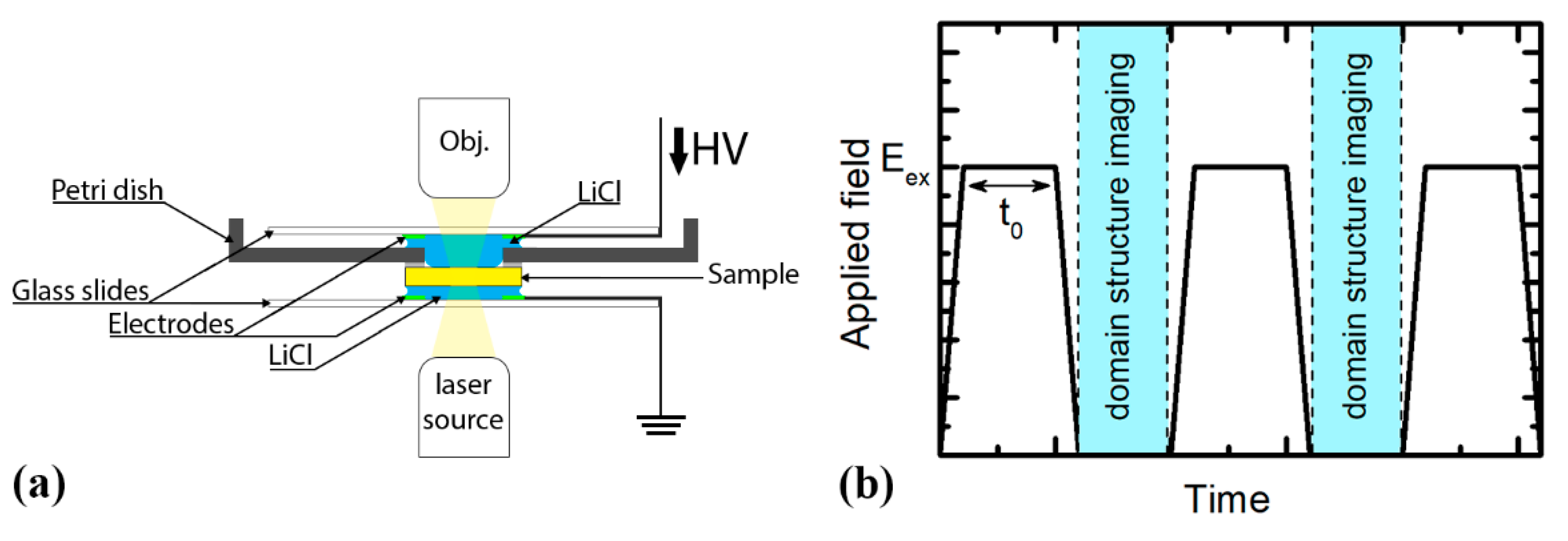
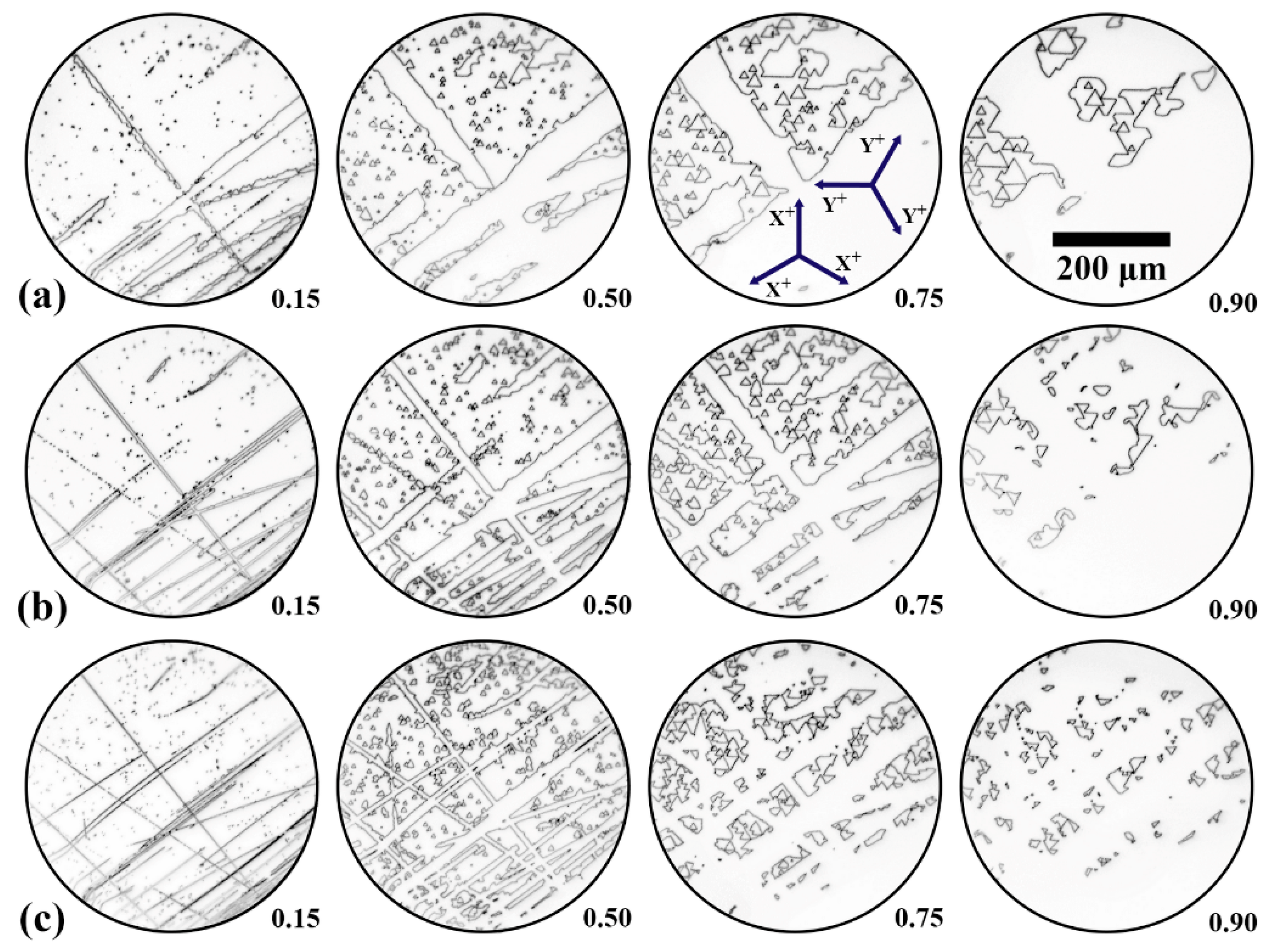
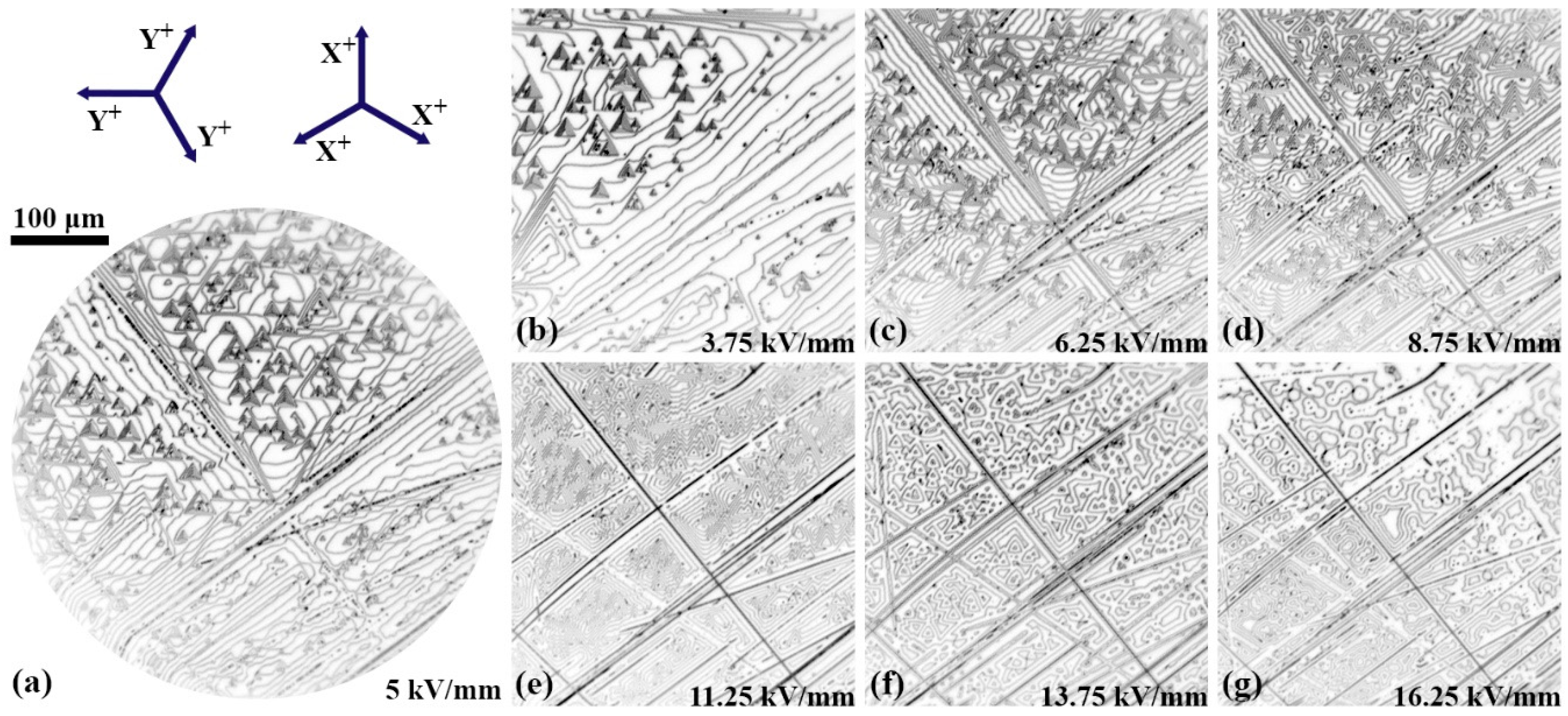

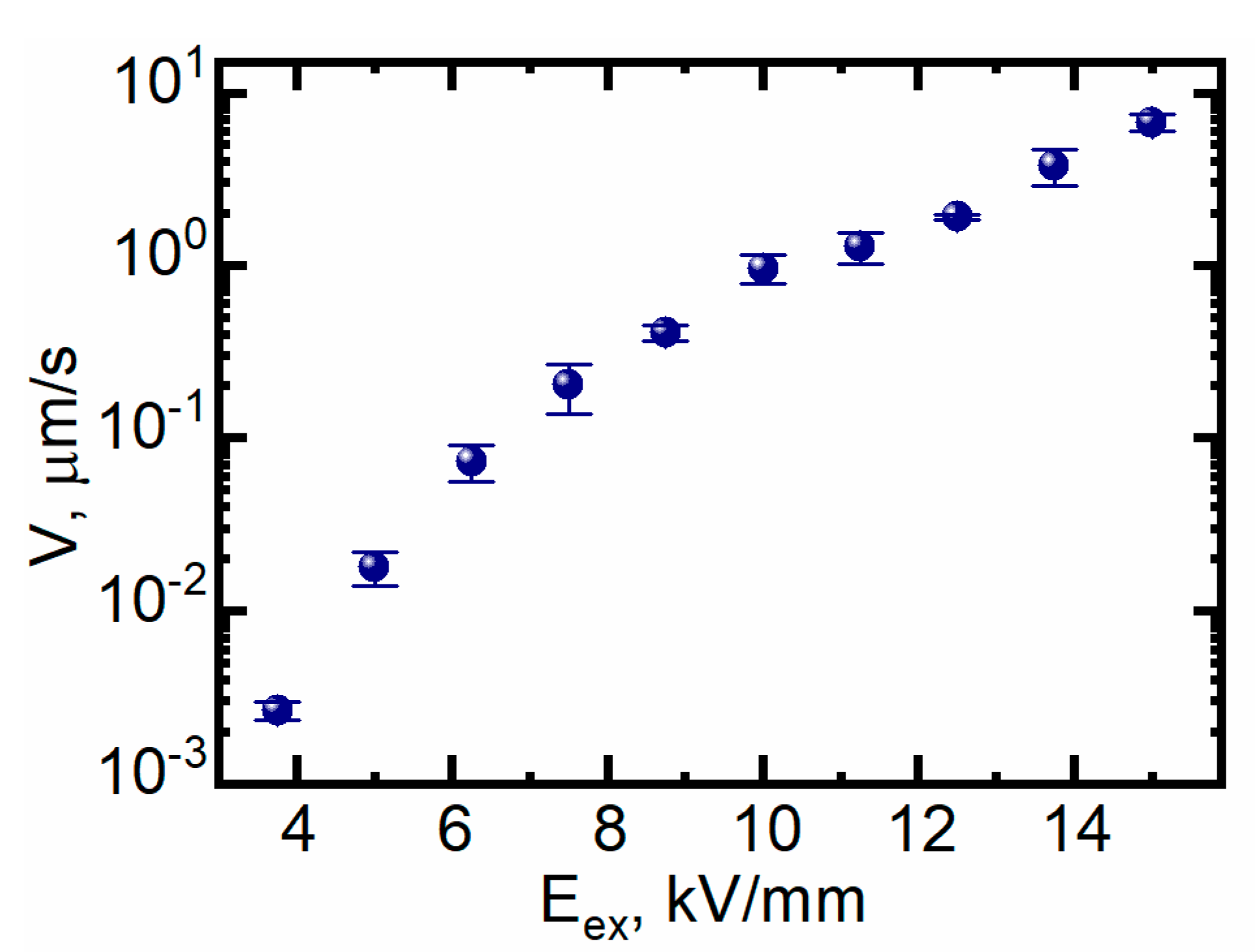
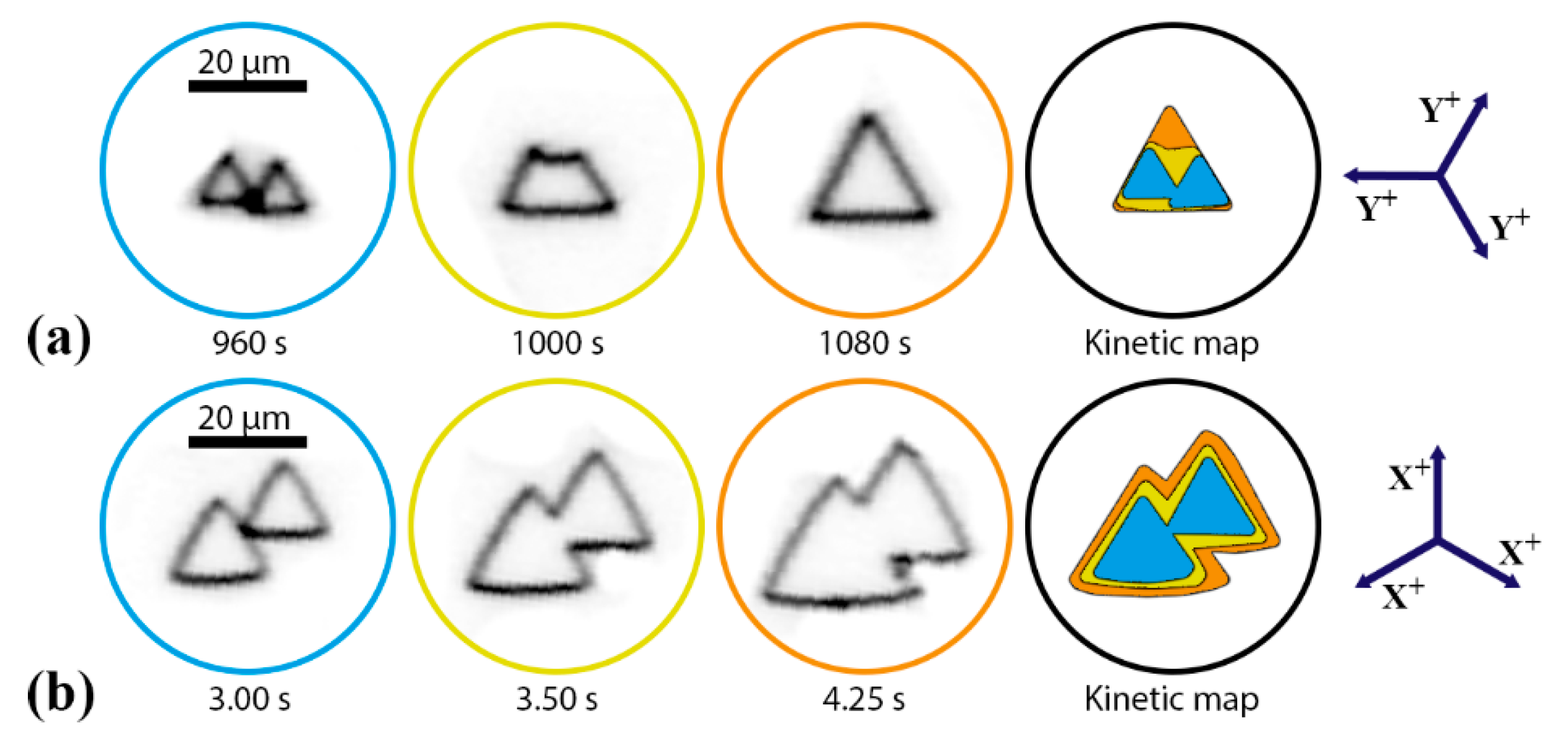
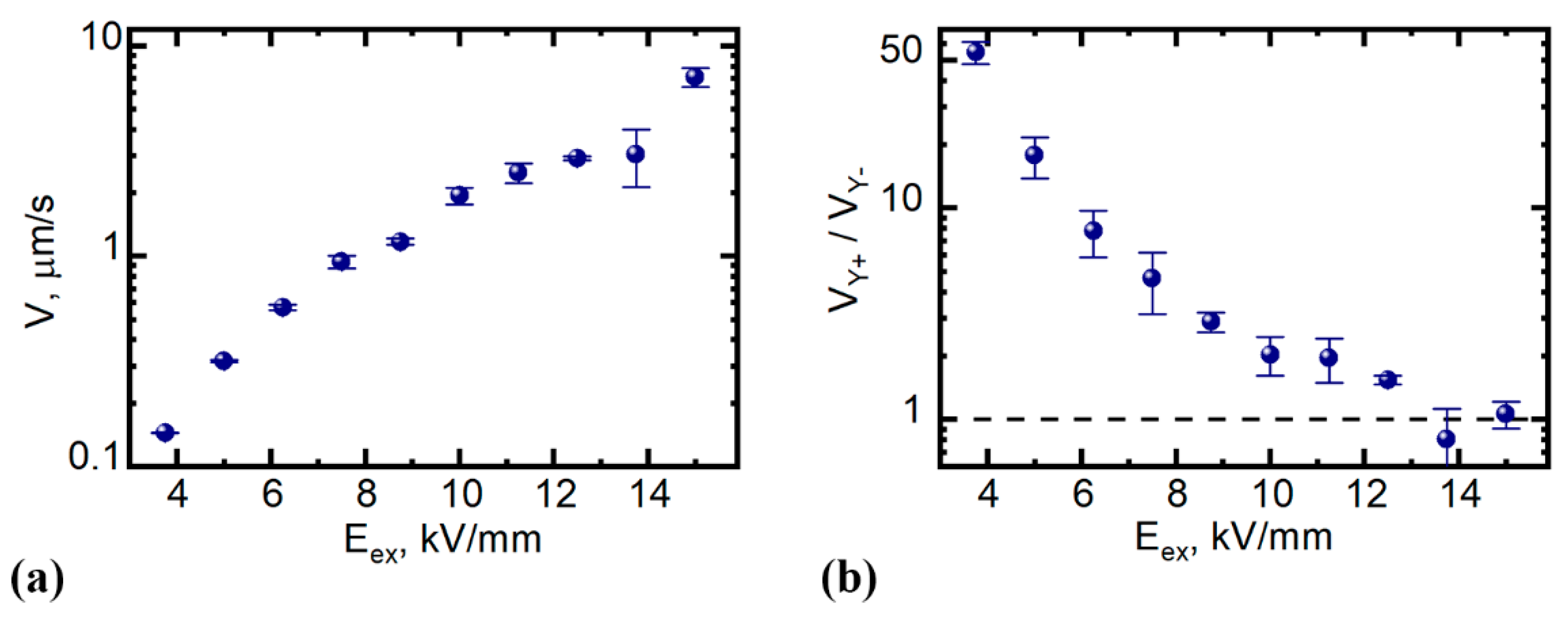

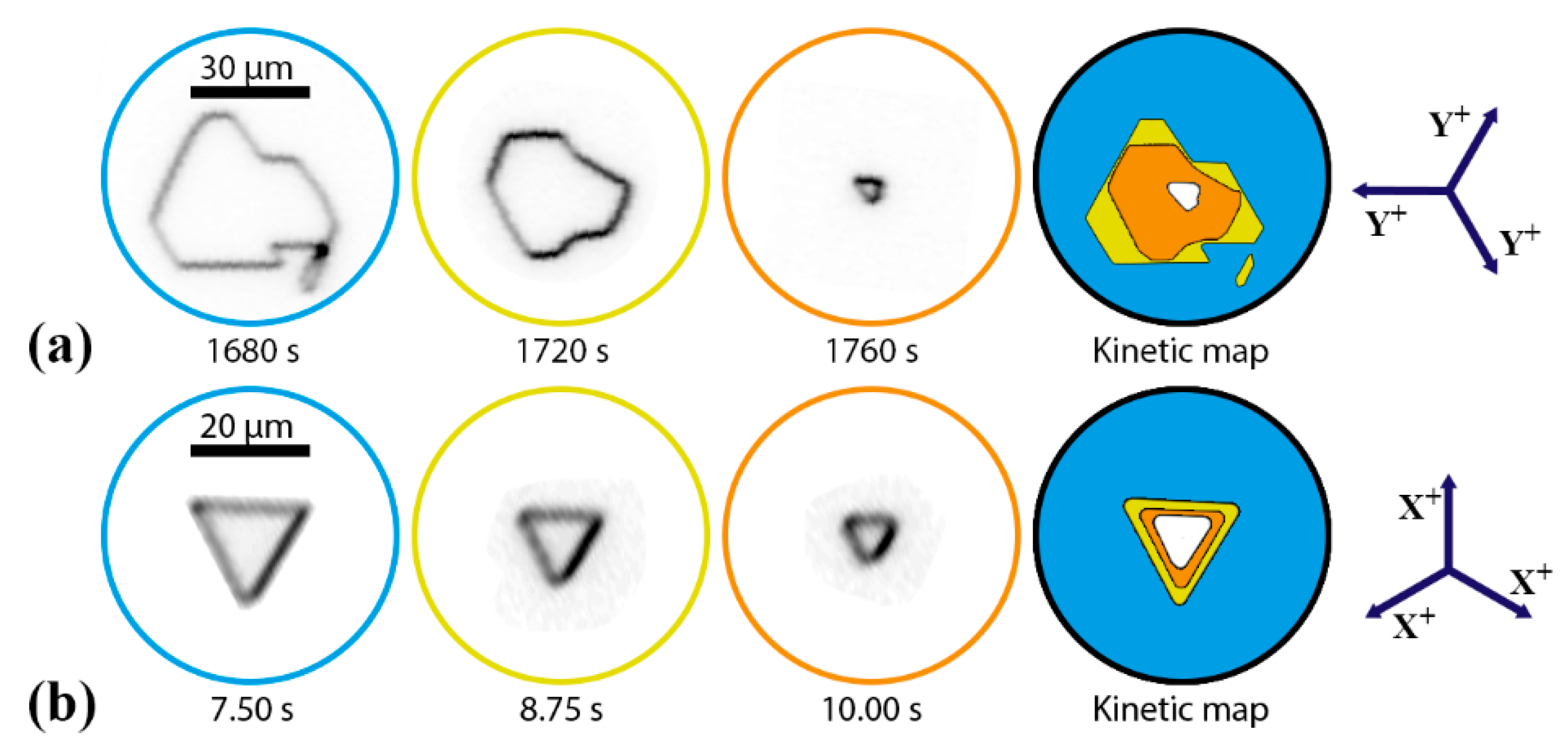

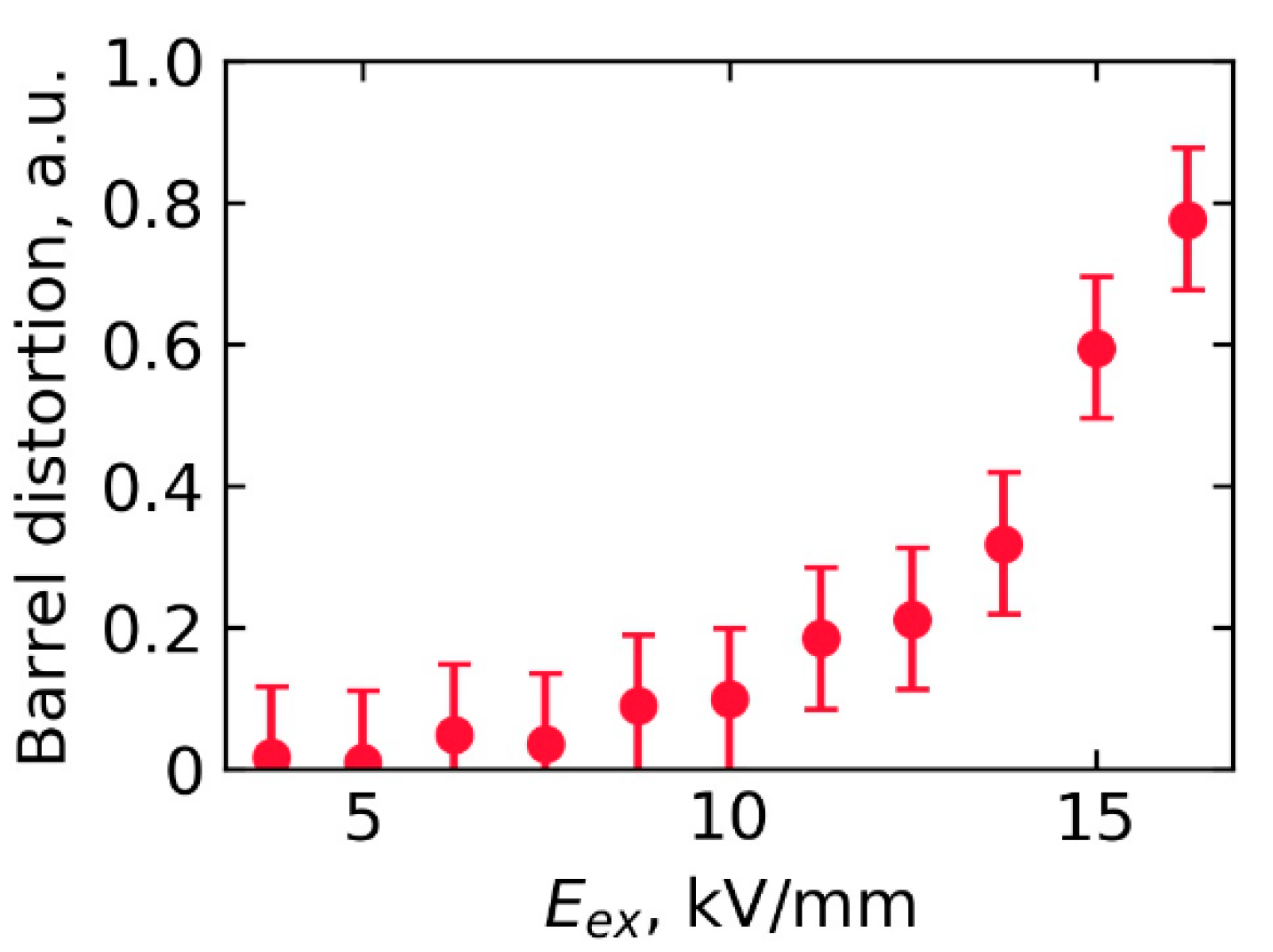
© 2020 by the authors. Licensee MDPI, Basel, Switzerland. This article is an open access article distributed under the terms and conditions of the Creative Commons Attribution (CC BY) license (http://creativecommons.org/licenses/by/4.0/).
Share and Cite
Akhmatkhanov, A.; Plashinnov, C.; Nebogatikov, M.; Milov, E.; Shnaidshtein, I.; Shur, V. In Situ Imaging of Domain Structure Evolution in LaBGeO5 Single Crystals. Crystals 2020, 10, 583. https://doi.org/10.3390/cryst10070583
Akhmatkhanov A, Plashinnov C, Nebogatikov M, Milov E, Shnaidshtein I, Shur V. In Situ Imaging of Domain Structure Evolution in LaBGeO5 Single Crystals. Crystals. 2020; 10(7):583. https://doi.org/10.3390/cryst10070583
Chicago/Turabian StyleAkhmatkhanov, Andrey, Constantine Plashinnov, Maxim Nebogatikov, Evgenii Milov, Ilya Shnaidshtein, and Vladimir Shur. 2020. "In Situ Imaging of Domain Structure Evolution in LaBGeO5 Single Crystals" Crystals 10, no. 7: 583. https://doi.org/10.3390/cryst10070583
APA StyleAkhmatkhanov, A., Plashinnov, C., Nebogatikov, M., Milov, E., Shnaidshtein, I., & Shur, V. (2020). In Situ Imaging of Domain Structure Evolution in LaBGeO5 Single Crystals. Crystals, 10(7), 583. https://doi.org/10.3390/cryst10070583





